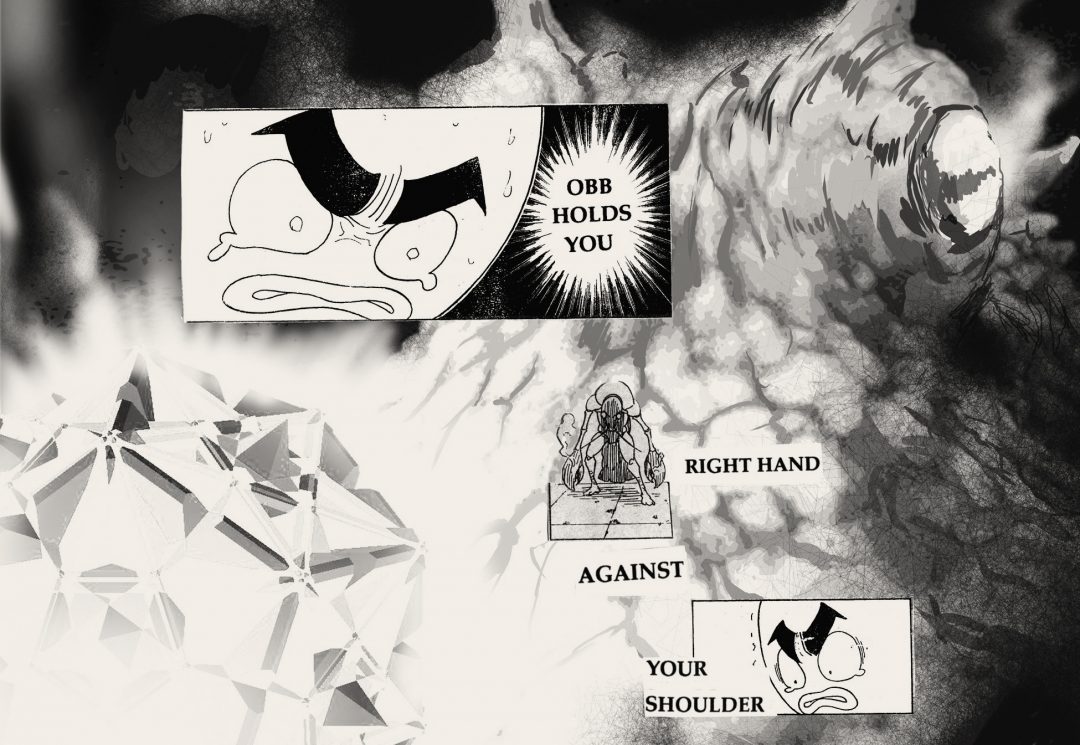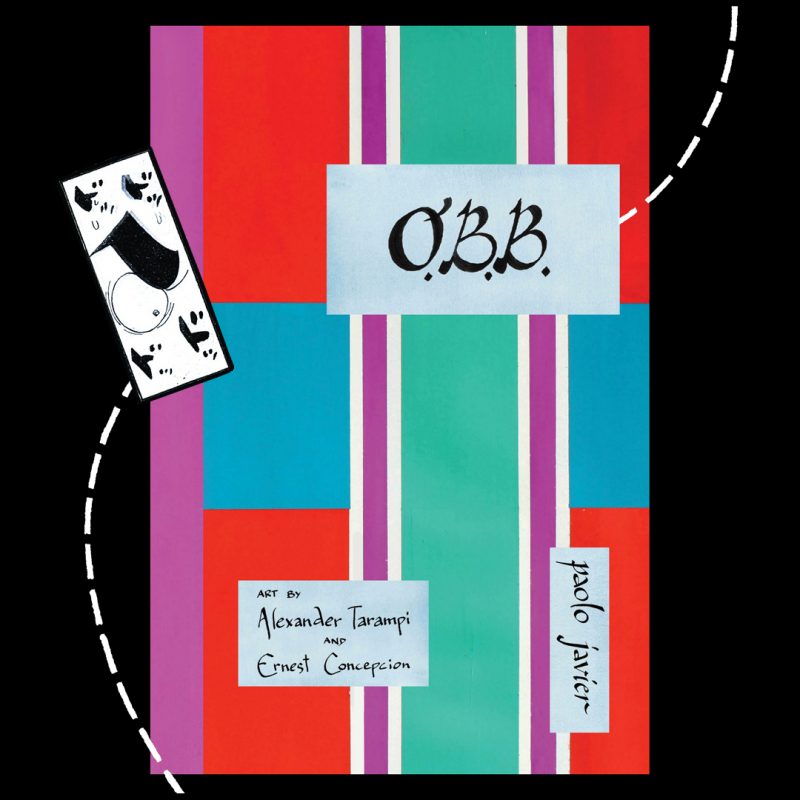USEREVIEW 055: Blowing Up the Book
In this tone-hopping traditional review, John Nyman buoyantly takes on the task of facing Paolo Javier’s challenging, genre-blending, Juvenalian poetry-comics hybrid book O.B.B. (Nightboat Books, 2021) featuring art by Alexander Tarampi and Ernest Concepcion.
ISBN 978-1-64362-072-5 | 280 pp | $22.95 USD — BUY Here
#CAROUSELreviews
#USEREVIEWEDNESDAY
Many books begin with a question of subject: What is this book about? A few, however, demand that we start somewhere even more fundamental: What (even) is this book? If you’re intrigued by the latter, you already have a lot in common with Filipino-American poet Paolo Javier’s new collaboration with visual artists Alexander Tarampi and Ernest Concepcion, O.B.B., a.k.a. The Original Brown Boy. Though ostensibly rooted in Javier’s transcultural negotiations of family, romance and artmaking, O.B.B.’s themes are neither stated nor assumed, but structurally emergent in its chameleonic oscillation of text fragments, cartoons and mixed-media artwork. Perusing O.B.B. means reading pictures and seeing words; it means pondering sharp juxtapositions of seemingly unrelated images and ideas; sometimes it means squinting at pixelated facsimiles, turning the book sideways or googling obscure references to New York City nightclubs. In other words, O.B.B. asks a lot. What it gives back will depend on the reader’s investment, engagement and trust in the book’s creative process, as Javier pursues genuinely new forms of collaborative meaning-making that balance radical individual autonomy with an appreciation for historical and cultural situatedness in a globalized world.
Inherently hostile to convention and expectation, O.B.B. is in many ways a downright weird book. Nonetheless, Javier is ultimately not content to let his work stand without a modicum of theoretical framing. In the more-or-less conventional scholarly essay that concludes O.B.B., Javier recounts how its 16-year genesis was inspired by the aesthetic overlap between poetry and comic books, as evidenced by creators including indie cartoonist Seth, graphic novelist Sonja Ahlers and DC Comics giant Grant Morrison. In Javier’s words, “no language art other than poetry can more greatly foreground the indeterminacy of meaning in literature to challenge language’s symbolic limits, and liberate the reader from the control of the writer.” Suggesting that Canadian avant-garde legend bpNichol in particular “anticipates many of [his] own formal interrogations in OBB [sic],” Javier emphasizes the poetic value of what comics theorist Scott McCloud calls “closure” — that is, the reader’s experience of actively imagining a complete narrative within “the space between the panels,” the comic-poem’s visual structure or rhythm of text and image.

But despite both Javier’s intellectual efforts and O.B.B.’s coinciding with “a rekindling of [his] childhood love of comics,” I’m doubtful that comic books offer the best formal lens through which to interpret Javier’s visual poetics. O.B.B. only occasionally employs the familiar multi-panel layouts most explicitly theorized by comic book artists like McCloud. Instead, the book’s visual compositions tend to resemble the collaged-and-mimeographed aesthetic of underground zine culture, while its juxtapositions of text- and image-dominant pages echo the early avant-garde bookmaking experiments of Dada and Surrealism (which Javier also cites as influences). Finally, the book’s arrangement into unpaginated sections — many featuring literary genres and graphical layouts distinct from those of their neighbours — suggests the look and feel of a scrapbook or yearbook, an effect emphasized by Javier’s opening the collection with pictures of rough drafts scrawled in a torn and doodled-in Hilroy exercise book. Overall, O.B.B. largely ditches the scripted, predictable tempo of graphic novels in favour of a more idiosyncratic structure that’s on the one hand less accessible, but on the other more broadly aware of the poetic potency of indeterminacy in its alchemical constructions of meaning.
In fact, Javier’s overall approach to artmaking may be most visible in the sections of O.B.B. that embrace conventional, text-centric book design, relegating comic panels and visual works to intervening pages. The bulk of ‘Restrained by Time,’ for example, is formatted as straight prose, although the content of that prose — an allegorical short with its own title, ‘Sharper than a Serpent’s Tooth’ — is anything but traditional. Its narrative centres on an absurd dialogue between the imperialist Yankee Soldier and MB or “Monkey Boy,” a Filipino man who speaks in unattributed Frantz Fanon quotations, as they discuss how to fairly divvy up a banana tree … well, actually, the Yankee Soldier just decides he’ll be taking the top half. Thematically, the piece conveys a clear political message, satirizing the narrator’s (who introduces himself as Uncle Sam) airheaded insistence on American supremacy in the Philippines while MB, all but completely ignored by his interlopers, waxes philosophical on Hegelian ontology and mixed-race ancestry.
Such a summary, however, utterly fails to capture the profound sense of disorientation that permeates Javier’s writing, which is chock-full of irregular grammatical constructions and eccentric non sequiturs. Take this paragraph as an example:
A good natured hint! The Yankee Soldier did not have to do any rooting to the ground as a stump. But the top part shriveled up and died. The Yankee’s stump, on the plant, and soon enough it makes Monkey Boy drool to extract from what had been his half.
The visual works included in ‘Restrained by Time’ are even more bizarre, reinforcing the sequence’s overall zaniness; for example, one of the more striking sketches features the all-caps slogan “WHY PRAISE INTERRACIAL STILL A WHITEMAN FACIALS” set above, um, isn’t that Frodo from The Lord of the Rings? At some points, particularly when I’m forced to wade through a stew of literary and pop cultural references far too thick for me to parse, ‘Restrained by Time’ seems to reconstruct the feeling of being talked down to by a colonial oppressor, one who commands authority despite their funny foreign language and patently nonsensical reasoning. At other points, Javier’s style implies a strategy of couching decolonial subversion in surrealist storytelling — both to sneak it into the canon as a Trojan horse, and to sharpen its barbs with hyperbole and dreamlike evocation. Alternatively, ‘Restrained by Time’ may simply mirror the ridiculousness of colonial relationships in general, along with their symptomatic creation of identities that can only be understood via the absurd. In any case, the piece is emblematic of Javier’s insistence on frontloading his work with question after question — and offering answers sparingly, if ever.
Where ‘Restrained by Time’ epitomizes O.B.B.’s interrogation of Javier’s Filipino heritage, the book’s other text-dominant section — a series of verse poems titled ‘Remain as Beast’ — exemplifies the other pole of his subject matter: his adult life and relationships in Queens, New York, which are typically illustrated through scattered memories and hyper-specific references. This treatment is evident in the following passage from ‘Endless Oneiros,’ which combines the grammatical perplexity of ‘Restrained by Time’ with an avalanche of allusive fragments reminiscent of the earlier, image-dominant sequence ‘Goldfish Kisses’:
Else heard swollen have make like million
Garden way time electrify beautiful adjust
“What in Heaven. It’s 825 pm
At Krystal’s and Ihawan. That I said it. To mean it
know Baby knock once we’ve never said while surrounded full
Filling in the temporal and conceptual space between his background and his contemporary lifestyle, Javier also bookends O.B.B. with references to his parents and his upbringing in Manila. But Javier’s work is by no means a biographical account of his life. Rather, it is best understood as an act of intense imagining, even a kind of purposeful distortion, that takes up the author’s lived experience as raw material. Much like the New York School poets that stand among his major influences, Javier tends to offer a straightforward sense of his general topic or tone (usually romantic or sentimental), but amid details that are almost impenetrably byzantine.

This is especially true of the images and short textual fragments that in fact make up the bulk of O.B.B., although they are difficult to comment on for several reasons. First, despite comprising more than 90% of the book’s whopping 280 pages, O.B.B.’s image-dominant sequences feel much less dense than their more conventionally formatted, text-dominant counterparts; often, my engagement with the former was enriched by scrolling through rapidly, as if each page were a single comic panel or flipbook frame, and gleaning significance from a bird’s-eye view. Second, authorship of these sequences is not straightforwardly attributable to either Javier or his collaborators, as the book’s informal author’s statement recounts a series of improvisational, even automatic back-and-forths between poet and artists that serve to thoroughly blur the lines of individuation. Nonetheless, the visual artworks included in O.B.B. produce a fabulous array of effects, including imaginative deconstructions of urban and architectural space, a litany of pop cultural references, fantastical explorations of character and identity formation and an occasionally breathtaking control of rhythm via repetition and collage. More importantly, the experimental methods evoked in both the reading and the creation of O.B.B.’s visual poetics are indispensable to modelling the “liberat[ion of] the reader from the control of the writer” that Javier places at the centre of his art.
All in all, O.B.B. represents an admirable effort to forge new ways of reading, albeit within a somewhat overcrowded avant-garde tradition. The book’s concluding essay in particular betrays Javier’s anxiety around earning literary recognition and legitimacy for his otherwise off-the-wall aesthetic. That anxiety may not be unwarranted, as there is a sense in which O.B.B.’s mashup of diverse compositional approaches suggests a kind of midpoint on the way to a masterwork still to come, an anthology of intriguing episodes in an otherwise unfinished story. On the other hand, that same feeling of incompleteness (remember Javier’s “indeterminacy”?) resonates conceptually with the always unstable compound of Filipino and American identities that defines Javier’s lived experience. Where both these characterizations of Javier’s work coincide is in their understanding that O.B.B. should perhaps be read less in awe of Javier’s product than with empathy toward his process — although that empathy will carry a curious and committed reader very far indeed.


John Nyman is a poet and critic from Toronto. His newest chapbook is The Devil (knife|fork|book, 2020). More: johnnyman.ca
